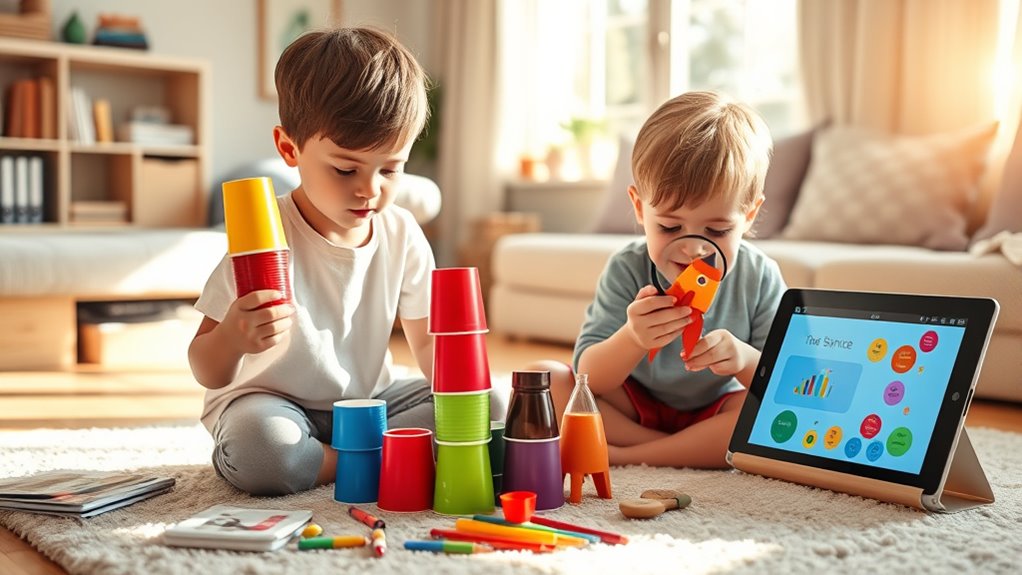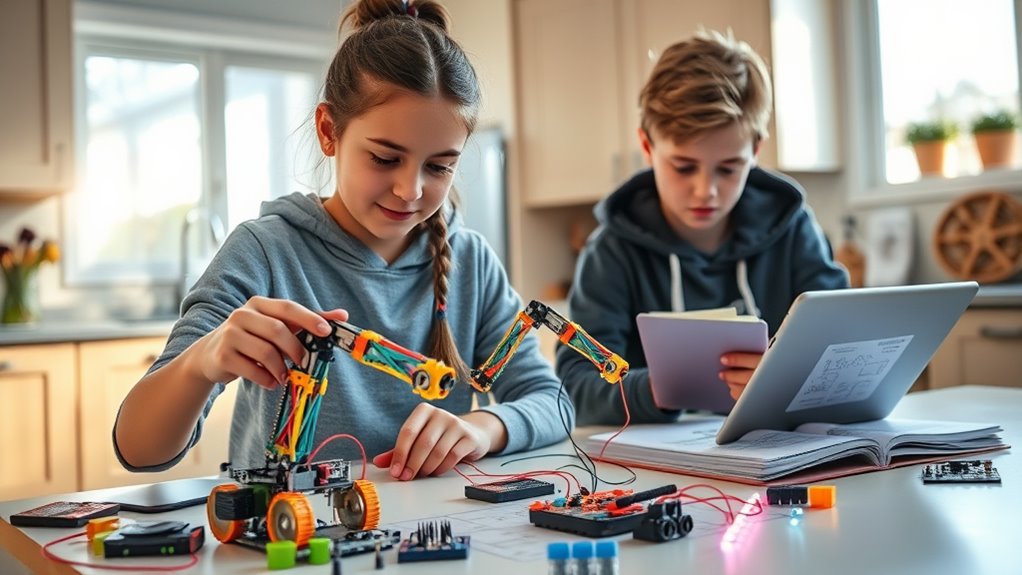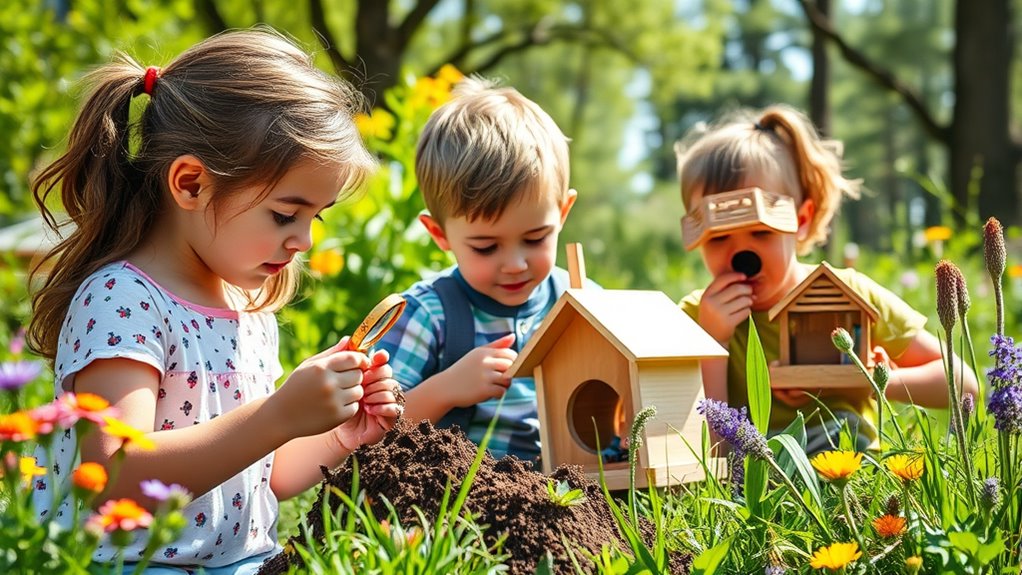Looking for STEM activity ideas tailored to different ages? You can explore sensory play and musical fun for toddlers, simple circuits and basic mechanics for early elementary kids, and energy experiments or environmental projects for older children. For teens, robotics and creativity combine, while outdoor nature activities and arts integrate learning across ages. Organizing engaging, hands-on projects keeps curiosity alive. Keep exploring further to discover how to adapt activities that grow with your child’s curiosity and skills.
Key Takeaways
- Offer age-appropriate activities like sensory play for toddlers, simple circuits for early elementary, and robotics for teens.
- Incorporate hands-on projects such as building bridges, solar ovens, or small machines suited to each age group.
- Use natural materials and outdoor exploration to connect children with the environment and promote sustainable STEM learning.
- Integrate arts and technology to foster creativity, problem-solving, and emotional expression across different developmental stages.
- Keep activities interactive, short, and engaging to develop curiosity and foundational STEM skills at every age level.
Activities for Toddlers and Preschoolers

Looking for fun ways to introduce STEM concepts to your little ones? Sensory bins are perfect for engaging toddlers and preschoolers, allowing them to explore textures, colors, and shapes while fostering curiosity. Fill a bin with rice, beans, or pasta, and hide small objects for kids to find, encouraging problem-solving and fine motor skills. Incorporate musical instruments like drums, shakers, or xylophones to introduce basic sound concepts. Let your child experiment with different materials, creating sounds and patterns, which helps develop auditory discrimination and early engineering skills. These activities combine sensory play with music, making learning interactive and enjoyable. Plus, they’re easy to set up at home, providing a hands-on way to nurture your child’s natural curiosity about how things work. Organizing space can also help keep your learning area tidy and inviting for young learners.
Early Elementary STEM Projects

Introducing STEM projects for early elementary students is a fantastic way to foster curiosity and critical thinking. You can help your child explore simple circuits by guiding them to connect batteries, wires, and small bulbs to create functioning lights. This hands-on activity introduces basic electrical concepts in a fun, understandable way. Additionally, experimenting with basic mechanics, like building simple machines from household items, encourages problem-solving and engineering skills. For example, constructing a basic lever or pulley teaches how forces work and improves their understanding of movement. These projects are engaging and accessible, perfect for young learners to grasp fundamental STEM principles while developing their confidence. Keep activities safe, simple, and playful to inspire a lasting interest in science and technology, especially when choosing vetted educational tools and resources to ensure safety and effectiveness.
Upper Elementary and Middle School Experiments

Are you ready to challenge your middle schoolers with more complex STEM experiments? Try exploring renewable energy by building simple solar ovens or wind turbines. These projects encourage them to apply the scientific method—posing questions, forming hypotheses, conducting experiments, and analyzing results. Encourage your students to test different materials for solar efficiency or adjust blade sizes on mini wind turbines. This hands-on approach deepens their understanding of renewable energy sources and how they work. Throughout these activities, emphasize observation, data collection, and critical thinking, helping them develop scientific reasoning. Additionally, understanding the principles of ethical hacking can inspire problem-solving skills applicable beyond science, fostering a mindset of security awareness. Not only do these experiments make learning engaging, but they also foster an understanding of sustainable solutions, preparing them to think about the future of energy.
High School and Teen Innovation Challenges

High school students can challenge themselves with robotics projects that test their engineering skills. Coding and app development enable teens to create innovative solutions and showcase their creativity. These activities push you to apply your knowledge and develop real-world skills through hands-on projects. Incorporating dog names inspired by popular culture or traditional Irish names can also add a fun and personalized touch to your projects.
Teen Robotics Projects
Have you ever wondered how teens are pushing the boundaries of innovation through robotics? Teen robotics projects challenge you to design and build functional robots that solve real-world problems. You’ll work with robot sensors to give your creations awareness of their environment, like detecting obstacles or following lines. Overcoming programming challenges sharpens your coding skills and enhances problem-solving abilities. As you experiment with sensors and motor controls, you learn how to integrate hardware and software seamlessly. These projects foster creativity and critical thinking, encouraging you to refine your designs through trial and error. Participating in high school robotics competitions or developing personal projects pushes your technical skills further while inspiring innovation. This hands-on approach makes STEM learning exciting and prepares you for future technological pursuits. Additionally, understanding how to integrate technology into your environment can enhance the functionality and aesthetic appeal of your projects.
Engineering Design Challenges
Ever wondered how teens turn their ideas into real-world solutions through engineering design challenges? These activities encourage you to apply problem-solving strategies to create innovative solutions. Focus on sustainable design by choosing materials and methods that minimize environmental impact. You might design a water filtration system, a renewable energy device, or an efficient transportation model. Throughout the process, you’ll identify problems, brainstorm ideas, prototype, test, and refine your designs. These challenges develop critical thinking and creativity while emphasizing real-world relevance. By tackling complex issues, you learn to balance functionality, sustainability, and resourcefulness. Incorporating eco-friendly approaches into your projects can significantly enhance their impact and feasibility. Engineering design challenges empower you to transform ideas into practical solutions, building confidence in your ability to solve problems with innovative, eco-friendly approaches.
Coding and App Development
Curious about how teens turn their ideas into innovative apps and coding projects? You can start by exploring block based coding, which simplifies programming concepts and makes learning fun. Using visual drag-and-drop interfaces, you’ll quickly see how code translates into actions, helping you develop problem-solving skills. Once you grasp the basics, move on to app prototyping—sketching out your app’s design and functionality before coding. This step allows you to visualize your project and make improvements early. Many platforms offer free tools tailored for teens, encouraging creativity and experimentation. Building apps from scratch or modifying existing ones boosts confidence and technical skills. With dedication, you can transform your ideas into functional, engaging apps that showcase your innovation and coding expertise.
Incorporating Technology and Coding for Younger Kids

Introducing technology and coding to younger kids can be both fun and educational when approached appropriately. You can start by exploring virtual reality experiences designed for children, which immerses them in engaging, safe environments that spark curiosity. Digital storytelling tools also offer a creative way for kids to combine coding basics with their imagination, allowing them to craft their own stories with visuals and sound. These activities help develop problem-solving skills and introduce fundamental tech concepts without overwhelming young learners. Keep sessions short and interactive, focusing on exploration rather than mastery. By integrating these age-appropriate tech activities, you encourage early interest in STEM fields while fostering creativity and confidence in your child’s digital abilities. Incorporating educational tools that support learning through play can further enhance engagement and understanding.
Hands-On Engineering Activities for All Ages

Hands-on engineering activities provide a practical way for learners of all ages to develop problem-solving skills and understand core STEM concepts. When exploring material properties, you discover how different materials respond to stress, weight, and environmental factors. Structural analysis helps you design stable structures, testing how beams or towers hold weight. These activities encourage critical thinking and creativity as you experiment with building materials, shapes, and designs. Understanding proper tire pressure is also essential for optimal performance and safety during activities involving bikes on various terrains.
- Test various materials for strength and flexibility
- Build bridges or towers to challenge structural stability
- Analyze how different shapes distribute weight
- Use everyday items to understand load-bearing properties
- Modify designs based on structural analysis insights
Engaging in these activities makes engineering concepts tangible, fostering a deeper understanding of how materials and structures work together.
Nature-Based STEM Exploration

Exploring nature helps you improve your outdoor observation skills and notice details others might miss. You can also try eco-friendly experiments using local materials, making your learning both fun and sustainable. These activities connect you with the environment while building your STEM knowledge in a hands-on way. Engaging with biodiversity hotspots can deepen your understanding of the importance of conserving diverse ecosystems.
Outdoor Observation Skills
Have you ever wondered what secrets nature holds just beyond your doorstep? Outdoor observation skills help you unveil those mysteries. Start by practicing wildlife tracking—look for footprints, droppings, or signs of animals. Try plant identification by noting leaf shapes, flower colors, and bark textures. These activities sharpen your attention to detail and deepen your connection with nature. Here are some ways to enhance your skills:
- Observe animal movement patterns
- Collect and compare different plant specimens
- Use a magnifying glass to examine textures and structures
- Record changes in the environment over time
- Map animal trails and plant distributions
- Participate in outdoor STEM exploration activities that integrate technology and nature.
Eco-Friendly Experiments
Did you know that you can conduct STEM experiments using natural and eco-friendly materials found outdoors? Eco-friendly experiments like recycling crafts help you learn about sustainability while creating something useful. For example, you can turn bottle caps into mosaics or use fallen leaves for natural art projects. Composting projects teach you about decomposition and nutrient cycles; you can set up a compost bin and observe how organic waste turns into soil. These activities promote environmental awareness and hands-on learning. Additionally, understanding the horsepower of electric dirt bikes can inspire ideas about energy and power in renewable projects. By using everyday natural materials, you make science fun while reducing waste and caring for the planet. Plus, outdoor eco-experiments encourage curiosity and a deeper connection with nature. It’s a simple way to combine STEM exploration with eco-conscious practices at home.
Creative Arts and STEM Integration

How can combining creative arts with STEM learning enhance your child’s educational experience? Integrating art therapy and musical innovation encourages creativity, problem-solving, and emotional expression. It helps children see connections between disciplines, fostering a well-rounded mindset. By blending arts with STEM, you promote hands-on exploration and critical thinking in engaging ways. Here are some benefits:
- Boosts creativity and innovation through hands-on projects
- Encourages emotional expression via art therapy techniques
- Develops problem-solving skills in musical composition
- Inspires curiosity about scientific concepts through art
- Strengthens confidence by creating unique projects
- Supports holistic development by integrating physical, emotional, and cognitive growth through Waldorf-inspired toys
This approach makes learning more enjoyable and meaningful, helping kids develop a growth mindset while discovering new ways to think and express themselves. Combining arts and STEM prepares them for future challenges by nurturing both the mind and emotions.
Frequently Asked Questions
How Can Parents Assess Their Child’s STEM Interests Effectively?
You can assess your child’s interests by observing their curiosity and engagement during activities. Try assessment strategies like asking open-ended questions, encouraging them to explore topics they enjoy, and noting which projects excite them most. Pay attention to their problem-solving approaches and the types of tasks they prefer. This hands-on observation helps you understand their true STEM interests, so you can support and foster their passion effectively.
What Safety Precautions Are Essential During At-Home STEM Activities?
Think of safety as the sturdy foundation beneath your child’s STEM adventures. You should always equip them with safety gear like goggles and gloves, turning potential hazards into manageable bumps in the road. Stay alert and practice hazard awareness, watching for sharp objects, chemicals, or electrical risks. Supervise closely, and create a safe zone where curiosity can flourish without fear, ensuring learning remains a joyful, injury-free journey.
How Can STEM Learning Be Adapted for Children With Special Needs?
You can adapt STEM learning for children with special needs by using inclusive tools that cater to their individual abilities. Incorporate adaptive strategies like sensory-friendly materials or modified instructions to guarantee engagement. Focus on hands-on activities that promote exploration and confidence, and always tailor your approach to their unique learning styles. This way, you create an accessible environment where every child can participate and thrive in STEM activities.
Are There Affordable Resources or Kits Recommended for At-Home STEM Projects?
Think of affordable kits as seeds you plant for your child’s curiosity. You don’t need a garden’s worth of money—budget-friendly resources like Snap Circuits or Chemistry sets offer engaging STEM projects without breaking the bank. These affordable kits provide hands-on learning that sparks creativity and problem-solving skills. With a little exploration, you’ll find options that fit your budget and inspire your child’s passion for science, technology, engineering, and math.
How Can Siblings or Peers Collaborate on STEM Activities at Home?
You can encourage siblings or peers to collaborate on STEM activities by setting up peer mentoring opportunities, where older kids guide younger ones through experiments. Try organizing collaborative experiments that require teamwork, like building a simple circuit or conducting a science experiment together. This fosters communication, problem-solving, and shared learning, making STEM fun for everyone. Keep activities engaging and age-appropriate to guarantee everyone stays involved and motivated.
Conclusion
So, go ahead, turn your living room into a mad scientist’s lab or a jungle of nature scavenges. Who needs boring textbooks when you can have explosive volcanoes or coding chaos? With a little imagination, you’ll have your kids mastering STEM while they think they’re just playing. Just don’t be surprised if your kitchen floods or your Wi-Fi crashes—welcome to the wild, wonderful world of at-home learning, where chaos is just part of the discovery!









